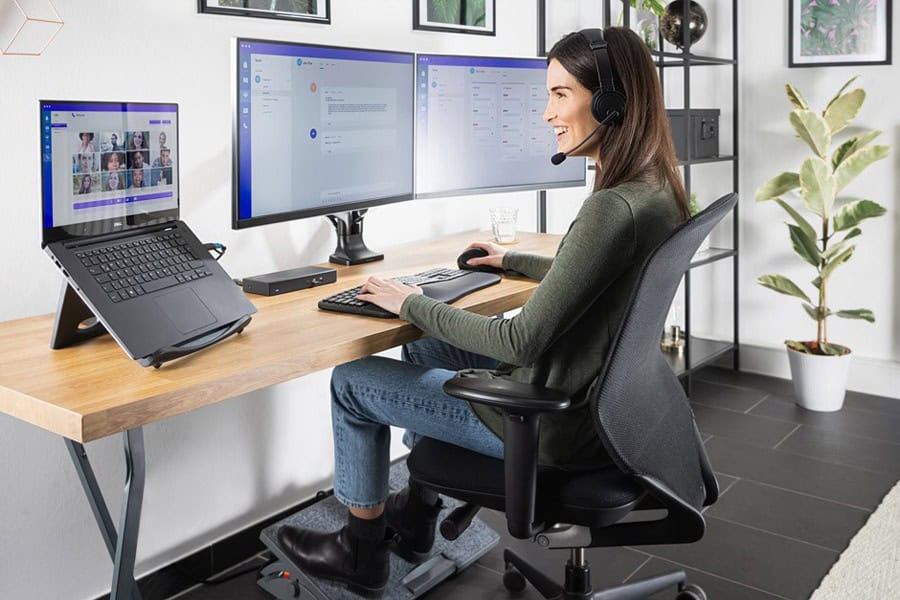Table of Contents
Creating an ergonomic desk setup is essential for ensuring comfort and efficiency during long hours of work. Whether you’re working from home or at an office, your workstation should promote good posture, reduce strain, and enhance productivity.
In this article, we’ll guide you through several key aspects of an ergonomic workstation which are all designed to help you maintain the best possible ergonomic position.
How to Create an Ergonomic Desk Setup

When designing an ergonomic workstation, it’s important to consider the overall layout of your desk setup, including how your monitor, keyboard, mouse, and other accessories are positioned. A well-arranged desk can prevent repetitive strain injuries, back pain, and even headaches. Here’s a step-by-step guide on how to set up your desk ergonomically:
Computer Monitor Placement
The position of your monitor is one of the most important aspects of an ergonomic desk setup. The monitor distance should be about an arm’s length away, and the top of the screen should be at or just below eye level. This helps prevent neck strain by ensuring you don’t have to look too far up or down.
If your monitor is too low or if the desk lacks depth, consider requesting a flat-screen monitor or moving your monitor to the corner. Using a monitor stand, adjustable arm, or an attachable computer tray can also help to raise it to the appropriate height.
Keyboard and Mouse Position
Your keyboard and mouse should be close enough to you that you don’t have to stretch your arms forward to reach them. Having the keyboard too low can cause you to extend your wrists as well, and wrist extension causes more pressure on your carpal tunnel.
Ideally, your elbows should be at a 90-degree angle when typing or using the mouse, with your wrists in a neutral position to reduce wrist pain.
A keyboard tray can be helpful to minimize strain on your arm and wrist posture. There are keyboard trays that come with wristrests and are large enough to accommodate both a keyboard and a mouse. Placing your mouse near the keyboard reduces the risk of repetitive strain on your shoulders and arms.
Adjust the speed of the cursor movement relative to the mouse movement so that it feels right for you. Additionally, you can alternate the left and right-sided mouse usage to reduce the effects of repetitive use.
Desk Height
The height of your desk plays a crucial role in maintaining a healthy posture. If your desk is too high or too low, it can lead to poor posture and discomfort over time. Ideally, your desk should allow your forearms to rest parallel to the floor while typing. Standing desks can be particularly helpful because they allow you to fine-tune the height to suit your body type.
Modular office furniture that allows you to adjust the surface height can also be helpful. You can ask your employer or facilities department to help you adjust such a desk.
Chair Adjustment
Your chair should be adjusted to ensure that your feet rest flat on the floor or on a footrest. Your thighs should be parallel to the ground, and your lower back should be supported by the chair’s lumbar support.
If your chair lacks proper lumbar support, you can add a cushion or lumbar support pillow to provide the necessary support for your spine. Getting an adjustable chair is also ideal as it comes with features that allow you to adjust the chair height, seat pan, and seat angle, letting you sit comfortably as you work.
Cable Management
An often-overlooked aspect of desk setup is cable management. A clutter-free workspace contributes to a more efficient workflow. Use cable ties, trays, or a docking station to keep cords organized and out of the way, reducing the risk of tripping or causing damage to equipment. Well-managed cables also improve the aesthetic of your workstation, making it easier to concentrate.
What Is the Best Ergonomic Position for Office?

The best ergonomic position for working at an office involves maintaining a neutral posture, which minimizes strain on your muscles and joints. Here are the key elements of this ideal position:
Head and Neck
Your head should be aligned with your spine, with your chin parallel to the floor. Avoid leaning forward or tilting your head up or down, as this can cause tension in your neck and shoulders. Adjust your monitor height if necessary to keep your head in this neutral position.
Shoulders and Arms
Keep your shoulders relaxed, not hunched or pulled back. Your upper arms should hang naturally by your sides, with your elbows at a 90-degree angle when typing or using the mouse. Avoid extending your arms too far forward or raising your shoulders, as this can lead to shoulder pain and fatigue.
Keeping necessary items close by using a drawer storage, document holder, and the like can also prevent you from extending your arms out.
Wrists and Hands
Keep your wrist position neutral with your hands resting comfortably on the keyboard or mouse. Avoid bending your wrist sharply upwards or downwards as this can lead to carpal tunnel syndrome over time. Consider using a wrist rest to help maintain the correct alignment if necessary. Additionally, consider using a split-design or a tented-and-raised keyboard.
Back Support
Sitting in awkward positions for prolonged periods can put stress on your spine, causing muscle fatigue, back pain, and more. Your lower back should be supported by the lumbar region of your chair as this will allow you to sit in a neutral manner, promoting proper posture.
If your chair doesn’t provide sufficient support, you can add a lumbar pillow. Ensure that your back is straight and your weight is evenly distributed across your hips.
Legs and Feet
Your thighs should be parallel to the floor, with your feet resting flat on the ground or on a footrest. Avoid crossing your legs, as this can cause misalignment of the hips and lower back. Make sure there’s enough clearance under the desk for your knees to move freely.
What Are the 5 Ergonomic Guidelines?

Following ergonomic guidelines helps ensure your workstation is optimized for comfort and health. Here are five essential guidelines for creating an ergonomic desk setup:
Maintain Correct Posture
Prolonged sitting with an improper posture is one of the leading causes of body pain. To counter that, one must adopt a neutral posture while working. It minimizes strain on the body and prevents musculoskeletal disorders.
Your spine should have a natural curve, your head should be aligned with your neck, and your wrists should stay straight. Ensure that your forearms can rest naturally with your elbows bent and your shoulders relaxed. Adjust your chair, monitor, and desk height to work in a comfortable position throughout the day.
Position the Monitor at Eye Level
To reduce eye strain and neck pain, adjust the monitor so that the center sits directly in front of your face or slightly below eye level. If you wear bifocals, tilt your computer screen slightly upwards towards your face or around 15 to 20 degrees below eye level.
If you use dual monitors, make sure the primary monitor is directly in front of you, and the secondary monitor is placed at an angle to reduce neck twisting. A monitor arm or adjustable stand can help achieve the proper positioning and a deeper working surface.
Keep Your Feet Flat
Your feet should rest flat on the floor or on a footrest to maintain proper leg positioning. Having your feet firmly planted helps improve circulation and prevents strain on your lower back. This will also keep your news and hips at roughly the same height. If your chair is too high and your feet dangle, using an ergonomic footrest is essential.
Use an Ergonomic Keyboard and Mouse
An ergonomic keyboard and mouse are designed to reduce strain on your wrists and arms. The keyboard should allow your wrists to remain straight while typing, and the mouse should be within easy reach. A split or curved keyboard can further enhance comfort by aligning your wrists and fingers more naturally.
Take Breaks and Move Around
Even with the best ergonomic setup, staying in one position for long periods can lead to discomfort. Prolonged sitting is also the cause of improper posture. Make sure to change your posture regularly by taking breaks every 30-60 minutes to stand, stretch, or walk around.
Moving your body regularly also helps promote circulation, reduces muscle stiffness, and improves overall well-being. Using a standing desk is ideal but if you only have a regular desk, you can create a small, secondary standing workspace yourself using various materials.
Creating an Ergonomic Workstation for Remote Workers

With more people working from home, it’s important to apply ergonomic principles to home offices. Setting up an ergonomic desk at home can be challenging due to space limitations, but here are some practical tips for creating a comfortable and efficient workstation.
Choose the Right Chair
Many home workers use dining chairs or couches for their office seating, which can lead to poor posture and discomfort. Invest in ergonomic chairs with good lumbar support and adjustability, allowing you to customize the chair height, seat depth, and angle to match your desk setup. If space is limited, consider a compact ergonomic chair or a sit-stand stool for flexibility.
Optimize Your Desk Space
If you don’t have a dedicated office desk, you can still optimize a dining table or other surfaces. Use a laptop stand or books to elevate your screen to eye level. Add an external keyboard and mouse to prevent wrist strain from prolonged laptop use.
A keyboard tray can also be a useful addition to maintain proper hand and wrist alignment. Add a docking station, a document holder, and additional storage to your desk as well to promote a functional workspace.
Lighting and Computer Screen Glare
Good lighting is essential to reduce eye strain. Place your monitor perpendicular to the closest natural light source if possible, but make sure there’s no glare on your screen. Use adjustable lamps with soft lighting to create a comfortable workspace that doesn’t strain your eyes.
Adjust the brightness and contrast of your monitor as well so that you can see clearly without unnecessary strain. You can also consider getting a dedicated pair of glasses for computer work.
Incorporating Ergonomics into Daily Habits

Creating an ergonomic desk setup is just one part of the equation. According to ergonomics experts, developing good daily habits is equally important to prevent strain and injury over time. Here are some habits to incorporate into your workday:
Practice Microbreaks
Microbreaks involve taking short, frequent breaks to rest your eyes, stretch, and move. Set a timer to remind yourself to take a break every 20-30 minutes. These breaks don’t have to be long—just 30 seconds of stretching or standing up can make a big difference.
Stretching Exercises
Incorporate stretching into your daily routine to keep your muscles limber and reduce stiffness. Focus on stretching your neck, shoulders, wrists, and back. Stretching not only reduces tension but also improves circulation, helping to prevent discomfort from sitting for long periods.
Ergonomic Workstation Assessment
Periodically reassess your workstation to ensure that it’s still aligned with ergonomic guidelines. As you acquire new equipment or make changes to your workspace, small adjustments may be needed to maintain an optimal setup.
Final Note
An ergonomic desk setup is crucial for maintaining comfort, productivity, and overall well-being in the workplace. Whether you’re working from a home office or a traditional office setting, following ergonomic guidelines such as proper monitor height, neutral wrist positioning, and regular movement will help reduce the risk of discomfort and long-term injuries.
Remember that no single desk setup works for everyone, so it’s essential to adjust your workspace to fit your unique needs and preferences. Prioritize your health and comfort by investing in an ergonomic workstation that allows you to work efficiently without compromising your well-being.
